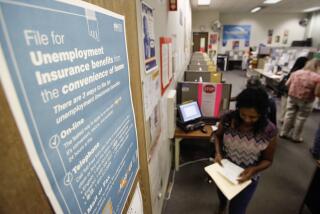Economists Upgrade Job Outlook in State
Citing evidence of spreading prosperity in the state and limited damage from Asia’s economic crisis and the El Nino storms, UCLA economists now believe job creation in California this year will match the spectacular performance of 1997, with exceptional growth in construction and continued gains in the manufacturing sector leading the way.
In its quarterly report released today, the UCLA-Anderson Forecast Project predicts that California will add 432,000 nonfarm jobs this year, for an increase of 3.3%, the same rate as in 1997. The job growth is almost 50,000 more than UCLA previously forecast at the end of last year when the Asian turmoil appeared more threatening and a national economic slowdown seemed more pronounced.
But more recent reports on employment, trade and housing have created a more favorable near-term outlook for both California and the nation. In January and February, California’s nonfarm employment grew by about 4% on a year-over-year basis. And so far, the crisis in Asia has been an overall plus, both statewide and nationwide, helping to reduce import and energy prices in the U.S., and boosting incomes and the housing market.
As a result, UCLA economists significantly raised their forecast for the nation’s output of goods and services, estimating that real gross domestic product will grow by 3.2% this year, compared with the forecast late last year of 2.6%. The economists added that consumer optimism in the nation is at near-record levels and inflation is flat.
“All this adds up to another good year for the U.S. economy, following an impressive performance in 1997,” economists Larry J. Kimbell and Rajeev Dhawan wrote in their national report, “Let the Good Times Roll.”
However, departing from the consensus view, Kimbell and Dhawan said they now expect the Federal Reserve Board to start making a move in the third quarter to raise the key interest rate because of growing inflation pressures resulting from the ever-tighter labor market. Many other economists think Asia’s troubles will cool down the U.S. economy enough this year to forestall such action from the Fed until next year. As expected, the central bank’s policymakers in a four-hour meeting Tuesday left the benchmark rate on overnight loans between banks at 5.5%.
UCLA’s California report, by Tom Lieser, focused on what he called the “renewed vigor, resilience and diversity” of the state’s economy. Even with weakness in Asia, Lieser said, California’s exports of goods increased at an annual rate of 10% in the fourth quarter. Lieser also downplayed other risks, including the recent wave of consolidation in aerospace and financial services in Southern California and the housing and transportation constraints in the Bay Area.
“The most impressive thing has been the performance of employment. Every major county is now doing better,” Lieser said, noting in particular San Diego and Orange counties and the Inland Empire, all of which last year saw payroll employment growth running at about 4% or higher.
“We knew Silicon Valley was in the ‘supernova’ category and it still is,” he said in an interview Tuesday. “But the prosperity is spreading around the state, and the negatives haven’t been very negative so far.”
Lieser predicted that all major sectors of California’s economy, with the exception of the federal government, will participate in the growth next year. Based on signs of a resurging housing and nonresidential market, he substantially raised his projection for construction employment, estimating that it will add 44,000 jobs this year for a growth rate of 8%. Manufacturing also should do better than previously thought, he said, noting that it will increase by an estimated 2.6% in 1998, largely on the strength of durable goods and high-technology manufacturing. The latest forecast also calls for personal income in California to rise by 6.4% and for taxable sales to maintain its 6% annual growth rate.
Other economists generally agreed with UCLA’s forecast. “There’s so much momentum out there,” said Jack Kyser, chief economist at the Economic Development Corp. of Los Angeles County.
Kyser and others, however, still expect Asia’s troubles to cut into California’s exports and slow the economy. In February, Kyser noted, containers leaving the Port of Long Beach were down almost 12%, and they slipped 6% in the Port of Los Angeles.
Mark Zandi, chief economist at Regional Financial Associates, a consulting firm in West Chester, Pa., said his forecast for California’s job growth in 1998 is 3.2%, just a notch below UCLA’s. But with Asia and labor shortages constraining expansion, Zandi expects the state’s employment machine to slow markedly to 1.7% in 1999, whereas UCLA is forecasting a growth rate of 2.6% in 1999.
Zandi also sees more risk in California’s surging home prices, with affordability again looming as a major issue. Northern California increasingly is struggling with soaring housing prices and short supplies, and Zandi says similar problems are likely to emerge soon in Southern California. UCLA’s latest forecast anticipates home values in Los Angeles County rising by 3.9% in 1998 and 4.8% the next year. But Zandi thinks prices in Los Angeles County will climb by 5.5% this year and 6.5% next year.
Stephen Levy, director of the Center for Continuing Study of the California Economy in Palo Alto, said he was not surprised by UCLA’s rosy outlook.
“So far in ‘98, the job growth is looking every bit as strong as ‘97,” he said. “I know that we all had fears that exports will plummet and jobs related to exports will plummet, and that hasn’t happened yet.”
More to Read
Inside the business of entertainment
The Wide Shot brings you news, analysis and insights on everything from streaming wars to production — and what it all means for the future.
You may occasionally receive promotional content from the Los Angeles Times.









